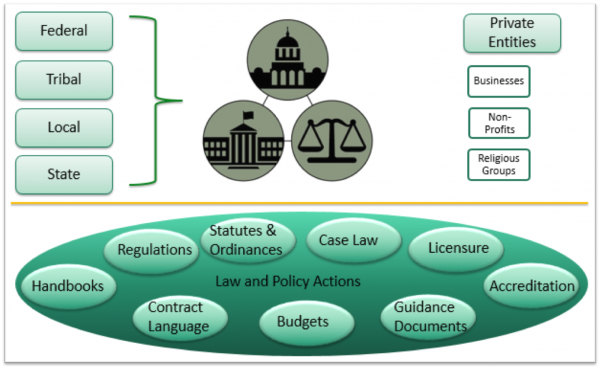This content was part of the Healthy People 2020 Law and Health Policy project, which ended in 2020.
Healthy People 2020 Law and Health Policy Project Webinar Summary
The Healthy People 2020 Law and Health Policy Project webinar held on October 30, 2019 — The Role of Law and Policy in Addressing Healthcare-Associated Infections — examined the impact of evidence-based law and policy approaches to reduce healthcare-associated infections (HAIs). It focused specifically on central line-associated blood stream infections. The webinar featured the following presentations:
Don Wright, MD, MPH, former Deputy Assistant Secretary for Health and Director of the Department of Health and Human Services (HHS) Office of Disease Prevention and Health Promotion (ODPHP), gave an overview of the Healthy People Initiative, the Healthy People 2020 Law and Health Policy Project, and the ways that laws and policies can help prevent HAIs.
Captain Arjun Srinivasan, MD, MPH, Associate Director for Healthcare-Associated Infection Prevention Programs, Division of Healthcare Quality Promotion (DHQP), Centers for Disease Control and Prevention (CDC), discussed CDC’s strategy to prevent HAIs and combat antibiotic resistance.
Peter Pronovost, MD, PhD, Chief Clinical Transformation Officer at University Hospitals, provided an overview of the national impact of HAIs and how health systems have found laws and policies helpful in preventing them.
Marion Kainer, MD, MPH, former Director of Healthcare-Associated Infections & Antimicrobial Resistance Program, Tennessee Department of Health (TDH), discussed the role of laws and policies in reducing HAIs from a state perspective.
Bernard Black, JD, MA, Nicholas D. Chabraja Professor at the Northwestern University Pritzker School of Law and Kellogg School of Management, provided cautionary notes on the slow progress on HAIs.
About Healthy People and the Law and Health Policy Project — Don Wright, ODPHP (former)
Healthy People is an HHS-led initiative aimed at improving population health and achieving health equity across the nation. For the past several decades, Healthy People has provided science-based national objectives and ambitious 10-year targets for improving the health of the nation. The initiative serves as a roadmap for health promotion and disease prevention efforts. Healthy People 2020 featured more than 1,200 objectives across 42 topic areas. It provided a framework for understanding where we were, planning for where we needed to be, and learning how to get there over the following 10 years.
The Law and Health Policy Project was a collaboration between ODPHP, the Centers for Disease Control and Prevention (CDC), the CDC Foundation, and the Robert Wood Johnson Foundation (RWJF). It aimed to improve the health of communities by sharing information about evidence-based law and policy interventions. The project used the best data to describe the health objectives and issues being addressed, and it created reports examining the relationship between population health and law and policy interventions. Specifically, it explored how law and policy can be useful tools to improve health.
Law and Health Policy Resources and Activities:
-
In-depth topic-specific reports
-
Bright Spots, which showcase ways legal and policy interventions can improve health in communities
-
Webinar series highlighting legal and policy research and approaches to address public health
- Resources to support the development of Healthy People 2030
About the Role of Law and Policy in Improving Health and Meeting Healthy People Targets — Don Wright, ODPHP (former)
The use of legal and policy approaches to advance Healthy People objectives has been a part of the initiative since its inception — and the Secretary’s Advisory Committee on National Health Promotion and Disease Prevention Objectives for 2030 specifically explored the potential role of law and policy in next iteration of the initiative, Healthy People 2030. In an issue brief focused on law and policy, the Committee conceptualized law and policy as determinants of health, explaining that they can serve as the structural engineers that shape conditions in areas that impact population health outcomes—like education and housing.
There are many law and policy activities and actions that can influence health, including statutes, ordinances, regulations, case law, and institutional policies. They can be adopted and influenced at multiple levels of government: federal, state, tribal, local, and even organizational. In addition, each branch of government — executive, legislative, and judicial — has a unique role in shaping the impact of laws and policies in ways that can help or hinder progress toward Healthy People objectives.
Figure 1: Overview of Law and Policy Activities and Actions
Related Healthy People 2020 Objectives
HAI-1: Reduce central line-associated bloodstream infections (CLABSIs)
HAI-2: Reduce facility-onset healthcare-associated methicillin-resistance Staphyloccocus aureus (MRSA) infections






